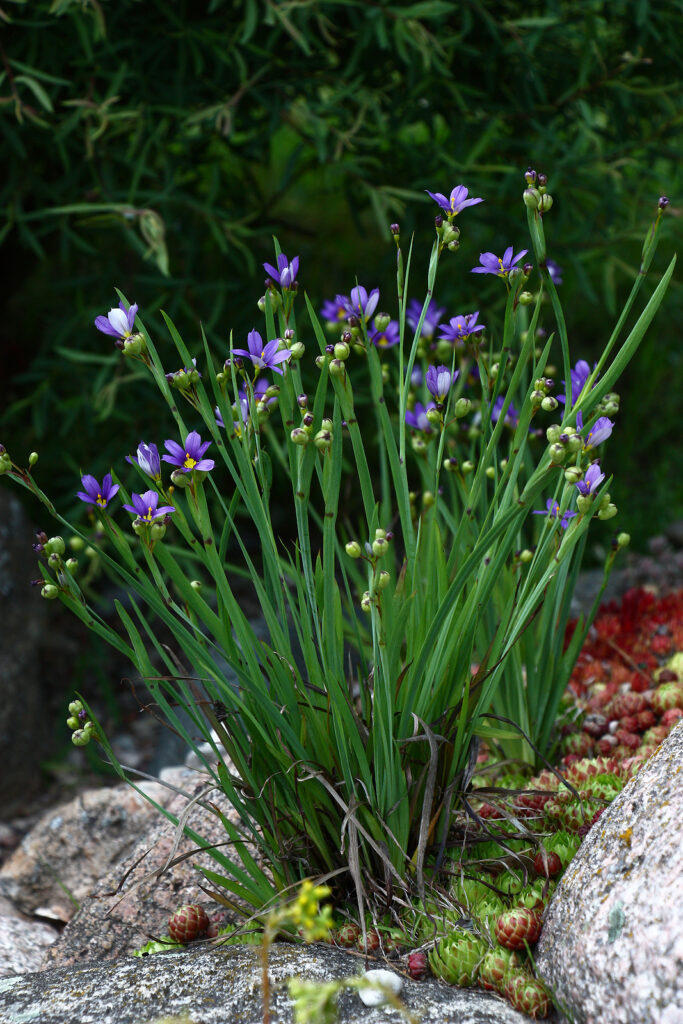Sisyrinchium – commonly called Blue-eyed grass–bears star, cup, or shallowly trumpet-shaped flowers that can be blue, yellow, mauve, white, and occasionally pink. The flowers appear in summer and are borne singly or in umbel-like clusters.
Sisyrinchium despite its common name is not a grass; it is a relative of the iris. Sisyrinchium produces clumps of linear grass-like to sword-shaped, most basal leaves, commonly in fans.
Sisyrinchium is best suited for informal gardens or naturalizing. Plant taller species in herbaceous borders; plant smaller species in rock gardens.
Sisyrinchium is a genus of about 90 species of annuals and rhizomatous perennials. Sisyrinchium is widely naturalized in North and South America. It can be found in habitats ranging from mountainous areas to meadows and coastal sands.

Get to know Sisyrinchium
- Plant type: Annuals and rhizomatous perennials
- Growing zones and range: Zones 3 to 10
- Hardiness: Hardy to 0°F (-18°C)
- Height and width: 1 to 2 feet tall and wide (.3-.6m x .3-.6m)
- Growth rate: Moderate
- Form and habit: Clump-forming
- Foliage: Clumps of linear to sword-shaped, mostly basal leaves, often forming fans
- Flowers: Upright, often winged stems bear star-, cup-, or shallowly trumpet-shaped, blue, yellow, mauve, white, or rarely pink flowers, either singly or in umbel-like clusters of 2-8; each cluster is enclosed in a pair of spathe bracts
- Bloom time: Spring and summer
- Uses: Rock garden, gravel planting, herbaceous border, informal gardens
- Common name: Blue-eyed grass
- Botanical name: Sisyrinchium
- Family name: Iridaceae
- Origin: North and South America
Where to plant Sisyrinchium
- Plant Sisyrinchium in full sun.
- Plant Sisyrinchium poor to moderately fertile, well-drained, neutral to slightly alkaline soil.
- Protect Sisyrinchium from excessive winter moisture.
Sisyrinchium uses and companions
- Use Sisyrinchium for vertical effect in formal and informal gardens.
- Plant Sisyrinchium in a herbaceous border or rock garden.
- Good garden companions for Sisyrinchium include Aquilegia, Artemisia, Coreopsis, Heuchera, Potentilla, Rudbeckia, Sedum, Senecio.
When to plant Sisyrinchium
- Set container-grown Sisyrinchium in the garden in spring or autumn.
- Sow Sisyrinchium seed in containers in a cold frame in autumn or early spring.
- Plants self-sow.
Planting and spacing Sisyrinchium
- Space Sisyrinchium 1-2 feet (.3-.6m apart).
How to water and feed Sisyrinchium
- Give Sisyrinchium regular to moderate water.
- Feed Sisyrinchium with 50% more of an all-purpose organic fertilizer than the average in spring.
How to care for Sisyrinchium
- Deadhead Sisyrinchium to prevent self-sowing.
Sisyrinchium pests and diseases
- Sisyrinchium are susceptible to aphids and spider mites.
- Rust can also occur.

Sisyrinchium propagation
- Divide Sisyrinchium clumps in spring or fall.
- Sisyrinchium seeds germinate in 7 to 14 days at 50º to 60ºF (10°-16°C); stratify seeds for 6 weeks in a refrigerator before sowing.
Sisyrinchium varieties to grow
- Sisyrinchium californicum, Golden-eyed grass, short-lived, semi-evergreen perennial with sword-shaped, gray-green leaves, to 6 inches (15cm) long. In summer, broadly winged stems bear a succession of star-shaped, dark-veined, bright, yellow flowers, .5-.75 inch (1-2cm) across. Self-seeds freely. To 24 inches (60cm) tall and 6 inches (15cm) wide. British Columbia to California.
- S. graminoides, Blue-eyed grass, clump-forming, semi-evergreen perennial with linear leaves, to 20 inches (50cm) long. In summer, erect stems bear a long succession of individually short-lived, iris-like, deep blue, yellow-throated flowers, .75 inch (2cm) across. Self-seeds freely. To 20 inches (50cm) tall and 6 inches (15cm) wide. North America.
- S. idahoense, California blue-eyed grass, clump-forming, semi-evergreen perennial with narrowly linear leaves, 3-12 inches (7-30cm) long. Uprightstems bear star-shaped, deep violet-blue flowers, 1 inch (2.5cm) across, with yellow throats, during summer. Self-seeds freely. To 5 inches (13cm) tall and 6 inches (15cm) wide. Washington and Idaho to California.















